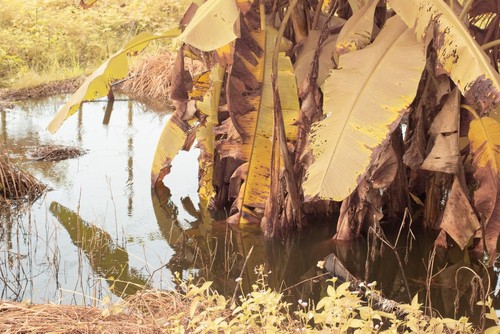Banana plants are a popular choice for gardeners and plant enthusiasts alike due to their tropical look and delicious fruit. However, one common issue that banana plant owners may encounter is drooping leaves. When banana plant leaves start to droop, it can be a sign of an underlying issue that needs to be addressed in order to keep the plant healthy.
Understanding banana plants is key to identifying the causes and symptoms of drooping leaves. Banana plants are herbaceous perennials that grow from underground rhizomes and can reach heights of up to 30 feet.
They require a warm and humid environment, well-draining soil, and plenty of sunlight to thrive. When these conditions are not met, banana plants may start to exhibit signs of stress, such as drooping leaves.
There are several causes of banana plant leaves drooping, including over or under-watering, transplant shock, a lack of sunlight, and bearing too much weight. Symptoms of drooping leaves may include wilting, yellowing, drying, and browning.
In order to prevent and treat drooping leaves, it is important to understand the underlying cause and take appropriate measures to address it.
Understanding Banana Plants
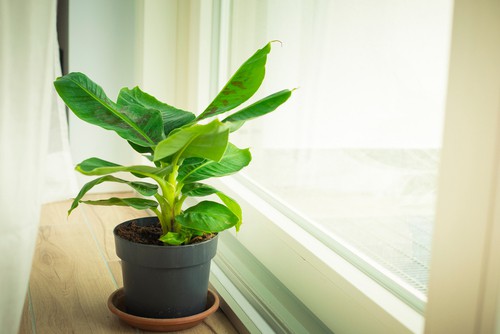
Banana plants are herbaceous perennials that belong to the Musaceae family. These plants are native to tropical regions of the world and are known for their large leaves and delicious fruit. In this section, we will discuss the life cycle of banana plants and the importance of leaves in banana plants.
Don’t miss out on these other top posts:
1. Life Cycle of Banana Plants
Banana plants have a unique life cycle that consists of three stages: vegetative growth, reproduction, and senescence. During the vegetative growth stage, the plant produces leaves and stems. These leaves are the site of photosynthesis, which is the process by which the plant converts sunlight into energy.
Once the plant reaches maturity, it enters the reproductive stage. During this stage, the plant produces a flower spike that emerges from the center of the plant. The flowers on the spike develop into fruit, which is the edible part of the banana plant.
After the plant has produced fruit, it enters the senescence stage. During this stage, the plant’s leaves begin to yellow and die off. The plant then goes dormant until the next growing season.
2. Importance of Leaves in Banana Plants
Leaves play a crucial role in the growth and development of banana plants. As mentioned earlier, leaves are the site of photosynthesis, which is the process by which the plant produces energy. Without leaves, the plant would not be able to produce the energy it needs to grow and produce fruit.
In addition to photosynthesis, leaves also help regulate the plant’s water balance. They do this by transpiring water vapor into the air. This process helps prevent the plant from becoming waterlogged, which can lead to root rot and other diseases.
Finally, leaves also help protect the plant from pests and diseases. They do this by producing chemicals that repel insects and other pests. Leaves also help prevent the spread of disease by producing enzymes that break down harmful pathogens.
In conclusion, banana plants are fascinating plants that play an important role in our lives. By understanding their life cycle and the importance of their leaves, we can better appreciate these amazing plants and the delicious fruit they produce.
Banana Plant Leaves Drooping – 6 Common Problems
Banana plant leaves drooping is a common problem that many gardeners face. There are several reasons why this may happen, and it is important to identify the cause so that you can take appropriate action to fix the problem. In this section, we will discuss the various causes of banana plant leaves drooping.
1. Watering Issues
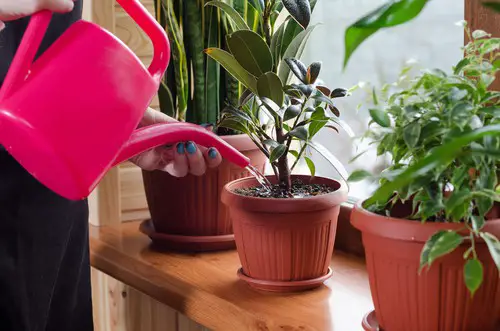
One of the most common causes of banana plant leaves drooping is watering issues. Overwatering or underwatering can cause the leaves to droop. If the soil is too wet, the roots can become waterlogged, leading to root rot and other problems.
On the other hand, if the soil is too dry, the plant will not get enough water, which can also cause the leaves to droop. It is important to find a balance and provide adequate water to the plant.
2. Temperature Influence
Extreme temperatures can also cause banana plant leaves to droop. In cold weather, the plant may become stressed and the leaves may droop as a result. On sunny days, the leaves may droop due to the lack of humidity and high temperatures. It is important to provide adequate shade and humidity to the plant to prevent this from happening.
3. Pest Infestation
Pest infestations can also cause banana plant leaves to droop. Aphids and other insects can transmit fungal diseases, causing damage to the plant and resulting in droopy growth. It is important to identify and treat pest infestations promptly to prevent further damage to the plant.
4. Nutrient Deficiency
Banana plants require adequate nutrients to grow properly. A lack of nutrients, such as potassium, can cause the leaves to droop. It is important to provide the plant with adequate nutrients through proper fertilization and soil management.
5. Weather Impact
Weather conditions can also impact banana plant growth. Heavy rain or strong winds can damage the leaves, causing them to droop. It is important to provide adequate protection to the plant during extreme weather conditions.
6. Transplant Shock
Transplant shock can also cause banana plant leaves to droop. When the plant is moved to a new location or repotted, it may become stressed and the leaves may droop as a result. It is important to transplant the plant carefully and gradually to prevent transplant shock.
Symptoms and Identification of Drooping Leaves
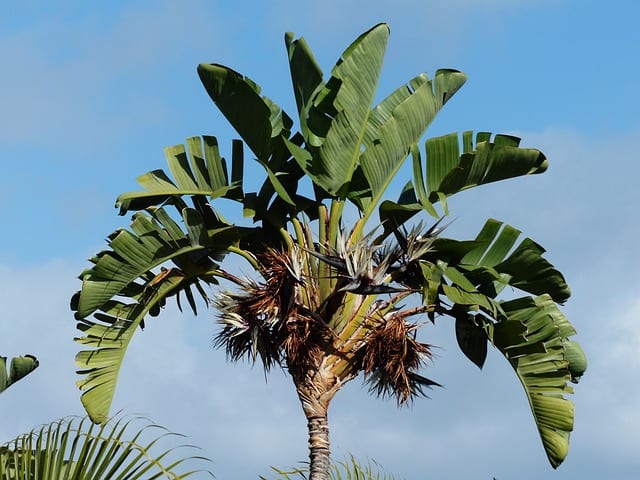
Banana plants are known for their large and lush leaves, but when they start drooping, it can be a sign that something is wrong. There are several symptoms that can help identify why banana plant leaves are drooping.
1. Yellowing of Leaves
Yellowing of leaves is a common symptom of banana plants that are drooping. This can be caused by a variety of factors, including overwatering, underwatering, nutrient deficiencies, and pests.
Overwatering can cause the roots to rot, which can lead to yellowing leaves. Underwatering can cause the leaves to dry out and turn yellow. Nutrient deficiencies, such as a lack of nitrogen, can also cause yellowing leaves. Pests, such as spider mites or aphids, can cause yellowing leaves as well.
2. Brown Spots
Brown spots on banana plant leaves can also be a sign of drooping. This can be caused by a fungal or bacterial infection, which can be spread through contaminated soil or water. Brown spots can also be caused by sunburn, which can happen when the plant is exposed to too much direct sunlight.
3. Indoor Banana Plant Symptoms
Indoor banana plants can also experience drooping leaves. This can be caused by a lack of sunlight or water, or by pests. Indoor banana plants should be placed near a window that receives plenty of sunlight.
If the leaves are drooping, it may be a sign that the plant is not getting enough water. The soil should be checked to make sure it is moist, but not waterlogged.
Prevention and Treatment of Drooping Leaves
Banana plants are known for their lush foliage and delicious fruit, but sometimes their leaves can start to droop. Fortunately, there are several preventative measures and treatments that can help revive your banana plant and prevent future drooping.
1. Proper Watering Techniques
One of the most common causes of drooping leaves in banana plants is improper watering. It’s important to keep the soil consistently moist, but not waterlogged. To achieve this, water deeply and slowly, ensuring that the water reaches the root system. It’s also important to avoid letting the soil completely dry out between waterings.
2. Appropriate Soil and Fertilization
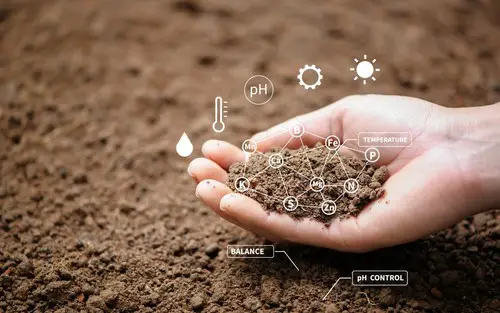
Banana plants thrive in well-draining soil that’s rich in organic materials. To promote healthy growth and prevent drooping leaves, consider using a potting soil that’s specifically formulated for bananas. Additionally, fertilize your plant regularly with a balanced fertilizer that contains potassium and iron. Compost can also be added to the soil to improve its nutrient content.
3. Providing Adequate Sunlight
Banana plants require plenty of direct sunlight to thrive, but too much direct sun can also cause drooping leaves. To strike the right balance, provide your plant with 6-8 hours of direct sunlight per day, but also ensure that it has access to shade during the hottest parts of the day.
4. Effective Pest Control
Pests can also contribute to drooping leaves in banana plants. To prevent infestations, keep your plant healthy and well-fertilized, and regularly inspect the leaves for signs of damage or pests. If you do notice an infestation, treat it promptly with an appropriate insecticide or pesticide.
5. Proper Support and Pruning
Finally, proper support and pruning can also help prevent drooping leaves in banana plants. Use stakes or other support structures to keep the plant upright, and prune away any damaged or diseased leaves or branches. This will help the plant conserve energy and direct its resources toward healthy growth.
By following these preventative measures and treatments, you can help ensure that your banana plant stays healthy and vibrant, with lush, green leaves that are free from drooping.
Special Care for Indoor Banana Plants
Indoor banana plants require special care to keep their leaves from drooping. This section will discuss three crucial aspects of caring for indoor banana plants: positioning and light requirements, watering and humidity, and repotting and soil requirements.
1. Positioning and Light Requirements
Indoor banana plants need adequate sunlight to thrive. Place them in a west-facing window or near a sunny window. However, direct sunlight can scorch the leaves, so it’s essential to provide filtered light. If the leaves are drooping, it could be due to a lack of adequate sunlight.
2. Watering and Humidity

Improper watering is the most common cause of indoor banana plant drooping. Overwatering can lead to root damage, while underwatering can cause the leaves to wilt. It’s essential to maintain a consistent watering schedule and monitor the soil’s moisture level. The top 2-4 inches of soil should be dry before watering the plant again.
Indoor banana plants also require high humidity levels to thrive. Dry air can cause the leaves to turn brown and wilt. To increase humidity, place a tray of water near the plant or use a humidifier.
3. Repotting and Soil Requirements
Indoor banana plants need well-draining soil to prevent waterlogging, which can lead to root rot. Repot the plant every two to three years, or when the plant outgrows its container. Use a potting mix that contains peat moss, perlite, and vermiculite to improve drainage.
Conclusion
In conclusion, banana plant leaves drooping can be caused by several factors, including watering issues, lack of sunlight, and bearing too much weight. Over-watering or under-watering the plant can lead to drooping leaves, yellowing, and falling off.
It is important to keep the soil moist but not waterlogged and to ensure that the plant is not exposed to direct sunlight for extended periods.
Transplant shock is another common cause of droopy leaves. When a banana plant is moved from one location to another, it may experience stress and exhibit signs of drooping. To prevent this, it is important to transplant the plant carefully and to provide it with adequate water and sunlight.
Finally, it is important to note that drooping leaves can also be a sign of pests or diseases. It is important to inspect the plant regularly for any signs of infestation or infection and to take appropriate measures to address the issue.
Frequently Asked Questions
Why are my banana plant leaves drooping?
Banana plant leaves can droop due to a variety of reasons, such as over or underwatering, transplant shock, lack of sunlight, and bearing too much weight. The most common causes are under-watering and transplant shock.
What causes banana plant leaves to droop?
Banana plant leaves can droop due to a lack of water, especially on hot, sunny days when the plant will conserve water by drawing it back from their leaves to their main stems and rhizome. Direct sun on the leaves paired with dry soil can also cause the plant leaves to droop. Transplant shock could also cause leaf drooping.
How can I fix drooping leaves on my banana plant?
To fix drooping leaves on a banana plant, water the plant thoroughly and make sure the soil is well-draining and moist. Provide 6+ hours of sunlight per day, but avoid exposing the plant to excessive direct sun when the soil is dry. If the plant is suffering from transplant shock, give it some time to recover and continue to provide it with proper care.
Is overwatering the cause of banana plant leaves drooping?
Overwatering can cause drooping leaves on a banana plant, but it is less common than under-watering. If the soil is consistently wet and the plant is not getting enough sunlight, the leaves may droop. It is important to make sure the soil is well-draining and not too wet.
Can underwatering cause banana plant leaves to droop?
Yes, underwatering is one of the most common causes of drooping leaves on a banana plant. If the top 2-4 inches of soil become too dry, this can result in drooping leaves. It is important to water the plant thoroughly and make sure the soil is moist, but not waterlogged.
What can I do to prevent drooping leaves on my banana plant?
To prevent drooping leaves on a banana plant, make sure the plant is getting enough water and sunlight. Keep the soil well-draining and moist, but avoid overwatering. Provide the plant with 6+ hours of sunlight per day, but avoid exposing it to excessive direct sun when the soil is dry. Additionally, avoid bearing too much weight on the plant.

Hey, I’m Lisa and I’ve been an avid gardener for over 30 years. I love writing, talking and living in the garden! Feel free to connect with me on my socials below

